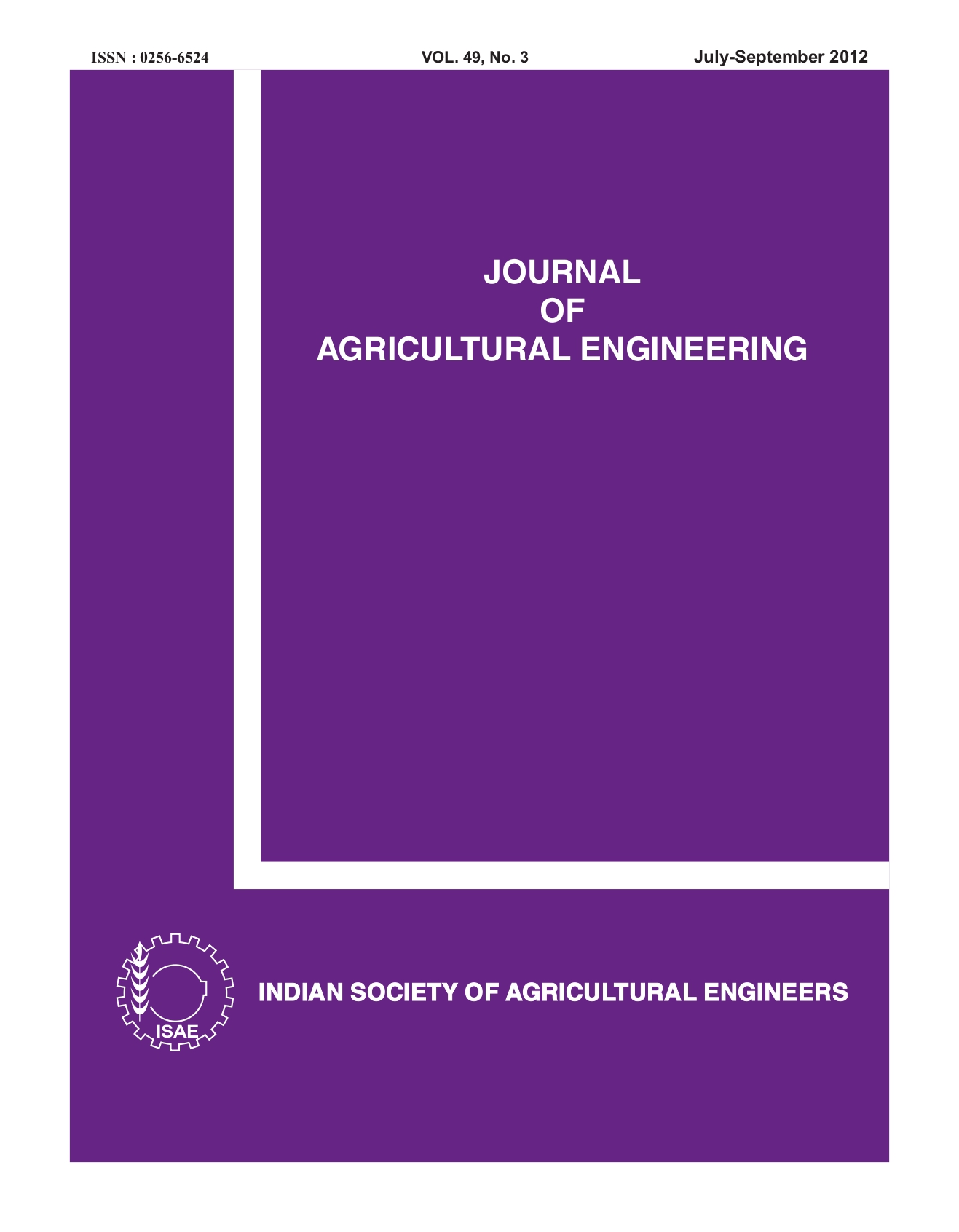Storage Behaviour of Guava Fruits in Evaporative Cool Chambers during Winter Season
DOI:
https://doi.org/10.52151/jae2012493.1482Keywords:
Evaporative cool chamber, rice husk ash, guava, relative humidityAbstract
Shelf life of guava in evaporative cool chamber during winter was evaluated on the basis of physiological loss in mass, acidity, total soluble solids and ascorbic acid. Results indicated that the evaporative cool chambers could be an ideal on-farm storage facility for maintaining quality and overall acceptability of guava. The average difference in dry bulb air temperature between ambient and evaporative cool chamber with river bed sand (ECC RBS) was 8.1 ºC, and between ambient and evaporative cool chamber with rice husk ash (ECC RHA) was 9.0 ºC during storage. Guava fruits stored in cool chamber had double shelf-life as compared to storage under ambient condition, and also had high organoleptic score. The evaporative cool chamber with risk husk ash was found to be more effective in reducing dry bulb temperature, elevation in relative humidity and increase in cooling efficiency than evaporative cool chamber with river bed sand.References
Abo-Allah I M; Gabal M R; Hassan F M; Aved T A; Hassanen S M. 1985. Physical properties of tomato fruit as affected by cultivar. Haryana Agri. Univ. J. Res., 10(1), 5-9.
Amerine M A; Pongborn R M; Rocssler E B. 1965. Principles of Sensory Evaluation of Food. Acedemic Press, London, pp: 602.
Babarinsa F A. 2006. Performance evaluation of an evaporative cooling system for fruits and vegetable storage in tropics. Agril. Mechanization in Asia, Africa and Latin America, 37(4), 60-65.
Baviskar M R; Waskar D P; Kaulgna S N. 1995. Effect of various post harvest treatments on ‘Umran’ ber fruit at low temperature storage. Indian Food Packer, 49(6), 45-52.
Camargo J R. 2007. Evaporative cooling: water for thermal comfort. J. Applied Sci., 3, 51–61.
Chandra P; Shrivastava R; Dash S K. 1999. Thermal behaviour of a fruits and vegetables storage structure. J. Inst. Eng., (AG-1) 80(1), 5.
Dadhich S M; Dadhich H; Verma R C. 2008. Comparative study on storage of fruits and vegetables in evaporative cool chamber and in ambient. Int. J. Food Eng., 4(1), 1–11.
Dhoot L R; Desai U; Rana D A. 1984. Studies on the shelf life of guava fruits with polyethylene packaging and chemical treatments. J. Maharashtra Agri. Univ., 9, 185 -188.
Dzivama A U; Igbeka J C; Audu I. 2006. Performance efficiency of an active evaporative cooling system for the storage of fruits and vegetables in a semi arid environment. Agril. Mechanization in Asia, Africa and Latin America, 37(4), 36-41.
Jha S N; Chopra S. 2006. Selection of bricks and cooling pad for construction of evaporatively cooled storage structure. Inst. Engineers, (I) (AG) 87,25–28.
Jha S N; Kudas Aleksha S K. 2006. Determination of physical properties of pads for maximizing cooling in evaporative cooled store. J. Agric. Eng., 43(4), 92–97.
Khedkar D M; Ansarwedkar K W; Dabhade R S; Ballal A L. 1982. Extension of storage life of guava var. L-49. Indian Food Packer, 36, 49-52.
Kumar J; Sharma R K; Singh R; Godara R K. 1996. Increased shelf life of kinnow mandarin (Citrus reticula) by different storage conditions and chemicals. Indian J. Agri. Sci., 60(2), 151-154.
Odesola I F; Onyebuchi O. 2009. A review of porous evaporative cooling for the preservation of fruits and vegetables. Pacific J. Sci. Technol., 10(2), 935–941.
Pal R K; Ahmed M S; Roy S K; Singh M. 2004. Influence of storage environment, surface coating and Individual shrink wrapping on quality assurance of guava (Psidium guajava) fruits. Plant Foods for Human Nutrition, 59, 67-72.
Prabha A; Sharma H R; Goel A K; Ranjana V. 2006. Changes in ascorbic acid content of lemon fruits stored in zero energy cool chamber and under ambient atmosphere. J. Dairying Foods Home Sci., 25(1),73–75.
Ranganna S. 2000. Handbook of analysis and quality control for fruits and vegetable products. Tata McGraw Hill Publ. Co. Ltd., New Delhi.
Roy S K; Khurdiya D S. 1986. Studies on evaporatively cooled zero energy input cool chambers for storage of horticultural produce. Indian Food Packer, 40(6), 26-31.
Sandooja J K; Sharma R K; Pandit M L; Batra B R. 1987. Storage studies to tomato in zero-energy cool chamber in relation to storage of maturity and packaging material used. Haryana Agric. Univ. J. Res., 17(3), 216–217.
Sinaga R M. 1986. Effect of maturity stages of tomato cv. Money Maker. Bull. Penelition Horti., 13(2), 43-53. Singh B P; Narayana C K. 1995. Storage behaviour of Dashehari Mango in ventilated poly bags. Indian Food Packer, 49, 29-31.
Singh G; Rajan S; Pandey D. 1993. Profits of guava. Intensive Agri., 31, 35-36.
Subburamu K; Singara V M; Naza A; Irullapan I. 1990. Effect of stage of harvest in tomato cultivars in improving the life and fruit quality. South Indian Hort., 38(4), 199- 263.
Venkatesha M; Reddy T V. 1994. Use of polyethylene bags to extend the shelf life of guava (Psidium guajava L.) fruits. Indian Food Packer, 48(5), 5-10.
Zahra G; John A B. 1996. A passive evaporative cooling system by natural ventilation. Build. Environ., 31(6), 503–507.














